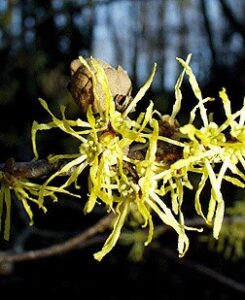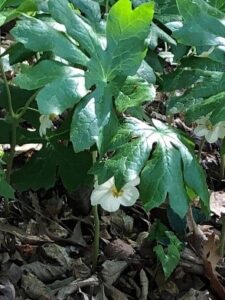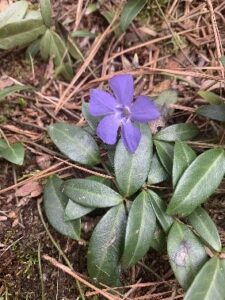Ask a Naturalist: Local Plants of Medicinal Value
Plants provide essential habitats for all living things—habitats meaning collective resources that enable organisms to live, defend and reproduce. Besides using plants as a resource for food and shelter, we depend on plants for natural resources and raw materials to make numerous things we use every day. Among these uses, medicine perhaps tops the list. In every time period, plants have been the origin of all medicines to treat illness and diseases. Even the synthetic compounds we use in modern medicine mimic natural compounds present in plants that different cultures have known about for centuries. Thus, modern medicine partly or wholly originates in ethnobotanical knowledge that was acquired and passed down by people of different cultures from around the world. The enormous range of plants used in medicine is beyond the scope of this brief article, but here are a few notable native and local plants of the Piedmont North Carolina that are valuable in producing the medicines we use today.
 American Sweetgum (Liquidambar styraciflua): Its characteristic star-shaped leaf is a common forest or ornamental deciduous tree that is native to eastern North America, including the Piedmont of North Carolina. Sweetgum trees prefer moist habitats and do not grow well in dry conditions. The name sweetgum originates in the gummy and balsamic sap that oozes from the bark when cut. The hardened sap traditionally used to chew is said to be the origin of the chewing gum we know today. The Native American tribes used all parts of sweetgum trees to treat various skin conditions and internal diseases. Ingredients from the Sweetgum tree have many uses in modern medicine; among the most important is perhaps as a base material for flu medicine. Sweetgum fruits are a major source of shikimic acid, the material for manufacturing the flu medicine Tamiflu. Sweetgum is a steady source of the compound, although other plants such as Star Anise and various pine species also contain shikimic acid at varying levels.
American Sweetgum (Liquidambar styraciflua): Its characteristic star-shaped leaf is a common forest or ornamental deciduous tree that is native to eastern North America, including the Piedmont of North Carolina. Sweetgum trees prefer moist habitats and do not grow well in dry conditions. The name sweetgum originates in the gummy and balsamic sap that oozes from the bark when cut. The hardened sap traditionally used to chew is said to be the origin of the chewing gum we know today. The Native American tribes used all parts of sweetgum trees to treat various skin conditions and internal diseases. Ingredients from the Sweetgum tree have many uses in modern medicine; among the most important is perhaps as a base material for flu medicine. Sweetgum fruits are a major source of shikimic acid, the material for manufacturing the flu medicine Tamiflu. Sweetgum is a steady source of the compound, although other plants such as Star Anise and various pine species also contain shikimic acid at varying levels.
 American Witch-hazel (Hamamelis virginiana): A relative of Sweetgum, Witch-hazel is a small shrub common to north and southeast North America that is found along stream banks in the shade of other trees. This is also one of the plants of medicinal value in the Native American culture to treat various skin ailments. Today, processed Witch-hazel water or cream is sold as an external antiseptic and astringent used to treat diaper rash and other minor skin conditions.
American Witch-hazel (Hamamelis virginiana): A relative of Sweetgum, Witch-hazel is a small shrub common to north and southeast North America that is found along stream banks in the shade of other trees. This is also one of the plants of medicinal value in the Native American culture to treat various skin ailments. Today, processed Witch-hazel water or cream is sold as an external antiseptic and astringent used to treat diaper rash and other minor skin conditions.
 Black Willow (Salix nigra): Black willow is found in moist soils along lakes and creeks, giving it the name swamp willow. Therapeutic values of the willow tree including the Black willow variety have been known around the world since ancient times and used for various medicinal purposes in the Native American traditions. Salicylic acid was isolated from willow trees in the mid 19th century and was found to reduce fever and pain. Later, a synthetic form of the salicylic acid was produced to make the most ubiquitous painkiller we know as our modern day Aspirin.
Black Willow (Salix nigra): Black willow is found in moist soils along lakes and creeks, giving it the name swamp willow. Therapeutic values of the willow tree including the Black willow variety have been known around the world since ancient times and used for various medicinal purposes in the Native American traditions. Salicylic acid was isolated from willow trees in the mid 19th century and was found to reduce fever and pain. Later, a synthetic form of the salicylic acid was produced to make the most ubiquitous painkiller we know as our modern day Aspirin.
 Mayapple (Podophyllum peltatum): Mayapple is a perennial wildflower that blooms with a single white nodding flower in spring (April-May) and bears small lemon-sized fruit. Native to most of eastern North America, it grows in colonies in shady woods and fields. All parts of the plant are extremely poisonous (with, at times, fatal hallucinogenic components) except for the ripened fruit. However, an Asian cousin of the Mayapple makes a compound called podophyllotoxin, which is used in manufacturing the cancer drug etoposide. Since the Asian species has been over-extracted to near-extinction, the American species is being considered as an alternative source for the cancer drug.
Mayapple (Podophyllum peltatum): Mayapple is a perennial wildflower that blooms with a single white nodding flower in spring (April-May) and bears small lemon-sized fruit. Native to most of eastern North America, it grows in colonies in shady woods and fields. All parts of the plant are extremely poisonous (with, at times, fatal hallucinogenic components) except for the ripened fruit. However, an Asian cousin of the Mayapple makes a compound called podophyllotoxin, which is used in manufacturing the cancer drug etoposide. Since the Asian species has been over-extracted to near-extinction, the American species is being considered as an alternative source for the cancer drug.
 Vinca: Although this herbaceous plant is native to Europe, Africa & Asia, two species of Vinca (Vinca major and Vinca minor) are commonly found in old home sites and cemeteries and also as ornamentals in evergreen gardens. A closely related species makes the chemotherapy agent vincristine used to treat different forms of cancer. As an introduced plant, Vinca forms a thick mat and tends to overgrow; therefore, caution is warranted before choosing this plant for gardening and other purposes.
Vinca: Although this herbaceous plant is native to Europe, Africa & Asia, two species of Vinca (Vinca major and Vinca minor) are commonly found in old home sites and cemeteries and also as ornamentals in evergreen gardens. A closely related species makes the chemotherapy agent vincristine used to treat different forms of cancer. As an introduced plant, Vinca forms a thick mat and tends to overgrow; therefore, caution is warranted before choosing this plant for gardening and other purposes.
When you dig deeper into how our cultures have evolved, you find our connection to the natural world in unlikely places. The medicinal value is just one of many links that reveal our connection to nature and is undoubtedly one of the numerous reasons to protect plant diversity. Maintaining rich biodiversity is the only way to coexist in nature and maintain our diverse cultures.